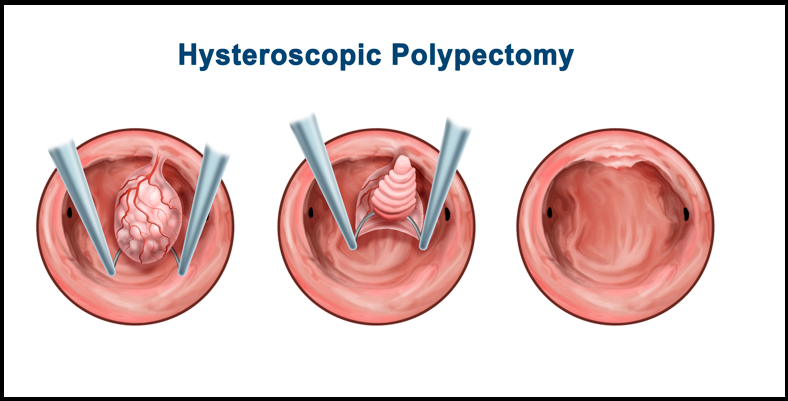
Hysteroscopy Polyp Removal
- Description
- Faq's
Cervical polyps are small, elongated tumors that grow on the cervix. The cervix is the narrow canal at the bottom of the uterus that extends into the vagina. The cervix connects the uterine cavity and the upper portion of the vagina. It acts as the passageway for sperm to fertilize an egg, which could result in pregnancy. During labor, the cervix becomes thinner and wider. This allows the baby to pass through the birth canal.
Polyps are fragile structures that grow from stalks rooted on the surface of the cervix or inside of the cervical canal. If someone has polyps, usually only one polyp is present, and two or three at most.
According to Harvard University, they’re most common in women in their 40s and 50s who’ve had more than one child. Polyps almost never occur in young women before the start of menstruation. Polyps are also common during pregnancy. This may occur due to an increase in the hormone estrogen.
Cervical polyps are usually benign, or not cancerous, and cervical cancer rarely arises from them. Most cervical cancers are due to the human papilloma virus (HPV), which is also the cause of genital warts.
Symptoms of cervical polyps
Polyps on the cervix may not cause any noticeable symptoms. However, see your gynecologist right away if you experience vaginal discharge of white or yellow mucus, or abnormally heavy periods.
You should also call your doctor if you experience vaginal spotting or bleeding:
- after sexual intercourse
- between periods
- after douching
- after menopause
Some of these symptoms can also be signs of cancer. In rare cases, polyps represent an early phase of cervical cancer. Removing them helps reduce this risk.
Ask your doctor how often you should get regular pelvic exams and Pap tests. Recommendations can vary depending on your age and health history.
Why polyps occur
It isn’t fully understood why cervical polyps occur. Their formation may be linked to:
- increased levels of estrogen, which is the female sex hormone
- chronic inflammation of the cervix, vagina, or uterus
- clogged blood vessels
High estrogen levels
Estrogen levels naturally fluctuate throughout a woman’s life. Your estrogen levels will be highest during childbearing years, during any pregnancies, and in the months leading up to menopause.
Man-made chemicals that mimic estrogen are present in the environment. For example, xenoestrogens are in commercially produced meats and dairy products. Chemical estrogens can also be released into food that’s heated in plastic or plastic foam containers. Even some air fresheners contain phthalates, which are other estrogen-like chemicals.
Inflammation
An inflamed cervix appears red, irritated, or eroded. Some of the known causes of cervical inflammation include:
- bacterial infection
- HPV infection, which can also cause warts/li>
- herpes
- yeast infections
- pregnancy
- miscarriage
- abortion
- hormonal changes
How cervical polyps are diagnosed
Polyps are easy for your doctor to see during a routine pelvic exam. Your doctor will see smooth, fingerlike growths on the cervix that appear red or purple. The two types of cervical polyps are ectocervical and endocervical.
Ectocervical polyps arise from the outer surface layer of cells on the cervix. Endocervical polyps arise from the cervical glands, and they’re the most common type of cervical polyp. Postmenopausal women are more likely to have ectocervical polyps, and premenopausal woman are more likely to have endocervical polyps.
Biopsies, or tissue samples, of the polyps are taken and sent to a laboratory for testing. Results usually show benign polyp cells. In rare cases, abnormal cells or precancerous patterns of growth known as neoplastic changes may be present.
Treatment of cervical polyps
Sometimes, cervical polyps will disconnect from the cervix on their own. This can occur while a woman is menstruating or during sexual intercourse.
Doctors don’t routinely remove cervical polyps unless they cause symptoms. Removing cervical polyps is a simple procedure that your doctor can perform in their office. No pain medication is necessary. Methods for removing cervical polyps include:
- twisting the polyp off at the base
- tying surgical string around the base of the polyp and cutting it away
- using ring forceps to remove the polyp
Methods to destroy the base of the polyp include the use of:
- liquid nitrogen
- electrocautery ablation, which involves using an electrically heated needle
- laser surgery
You may feel a brief, mild pain during removal and mild to moderate cramps for a few hours afterward. Spotting of blood from the vagina may occur for one or two days after removal.
In some instances, the polyps or the polyp stems are too large to remove in a doctor’s office. If this is the case, you may need to have surgery to remove the cervical polyp in a hospital or surgery in a hospital or surgery center.
